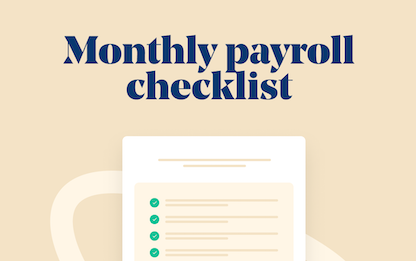- Blog
- |Managing Payroll
- >PAYE and Tax
- >prepare for the new tax year
How to Prepare for the New Tax Year


April is fast approaching. Before you know it, we'll be knee-deep in P60s and P11Ds.
With so much to do, it's important to know the key dates for your year-end tasks. There are particular deadlines for issuing and submitting forms; it's essential to meet these to remain compliant and avoid penalties from HMRC.
Now is also an excellent time to ensure you're up to date with any new tax legislation changes.
Year after year, our mantra at PayFit is always the same - the sooner you start preparing, the easier the end of the tax year will be.
When is the end of the tax year?
Here in the UK, you have until the 5th of April to complete your taxes.
On this day, the tax year ends, and the next one begins the following day (the 6th of April). We refer to this period as the financial year.
In this way, the tax year is different from the standard calendar year, though it still lasts for 12 months.
What are the dates you should keep in mind?
As we mentioned before, HMRC observes some very specific deadlines for issuing and submitting forms.
And there are quite a few forms.
It can get a little stressful, which is why we've put together this handy checklist, so you never have to worry about missing another deadline again.
Want to know more about the documents you'll need to fill out? Then read on - we'll be going over these one-by-one along with their respective deadlines.
Important forms for the end of the tax year
Final FPS
Known as the Full Payment Submission (FPS), this type of document needs to be submitted to HMRC every time you pay your employees. On it, you must include employee details like gross pay, income tax and National Insurance contributions. It will also show how much your organisation owes HMRC.
You'll need to submit all your FPS forms before the end of the tax year.
Final deadline: final payday of the closing tax year
Final P46 car return
If you provided company cars to employees, stopped providing a company car or offered an employee an additional vehicle, you’ll need to fill this out in addition to your year-end P11Ds.
Final deadline: the 5th of April for electronic submissions, the 3rd of May for paper submissions
Final EPS
An Employer Payment Summary (EPS) is used to record additional values that are not reported on an FPS (see above). As these values affect any payment you make to HMRC, either monthly or quarterly, they need to be reported. Recovery and compensation for statutory payments, apprenticeship levy, and CIS deductions are some of the things you’ll need to include on an EPS.
Final deadline: the 19th of April
Issued P60s to employees
When it comes to your employees, you need to make sure they get their P60s. The P60 is a crucial piece for employee record-keeping. It includes the employee's National Insurance contributions, statutory pay, student loan repayments, gross earnings and tax paid on the previous year. You must provide a P60 to any employee who was employed by you as of the 5th of April 2023.
Final deadline: the 31st of May
Submit PSA1 form (if applicable)
If you need to notify HMRC about any items included in a PAYE Settlement Agreement (PSA), you’ll need a PSA1. The PSA agreement is what allows employers to make a one-time annual payment for tax and National Insurance (NI) purposes on irregular or minor expenses and benefits. In other words, any items that don’t need to be recorded on P11Ds should be included here.
Learn more about what a PAYE Settlement Agreement (PSA) is and what you need to do for it as a business.
Final deadline: the 6th of July
Submit P11Ds and P11D(b) to HMRC
Taxable benefits employees received during the tax year that haven’t been payrolled or recorded in a PAYE Settlement Agreement (PSA) must be included on a P11D. You’ll need to fill this form out on behalf of every employee before submitting them to HMRC. You’ll also need to make copies for each employee for record-keeping purposes.
In addition to completing P11Ds, you’ll also need to submit a P11D(b). This form notifies HMRC how much Class 1A National Insurance is due on all the expenses and benefits you’ve provided for your employees through payroll.
Final deadline: the 6th of July
Pay Class 1A NIC payment to HMRC
If you provide any kind of benefit to your employees, you’ll need to make Class 1A National Insurance Contributions. This is an employer-only contribution that you'll need to make on any taxable benefits you've provided through payroll or added to your employee's P11D.
Final deadline: Due on the 19th of July if paying by post, otherwise due on the 22nd of July.
Pay tax & NIC due from PSA
Any PAYE Settlement Agreement (PSA) you agreed to with HMRC will also incur a tax and Class 1B National Insurance Contribution.
Remember that a PSA allows you to fulfil tax obligations on your employees' behalf for specific benefits and expenses. Since paying tax for an employee is seen as a benefit in kind in itself, there's tax due on top of that tax.
If your head is spinning, don't worry - payroll software like PayFit, can automate these kinds of tax calculations for you.
Final deadline: October 22nd
Never miss a deadline again
Taking the fuss out of payroll is what we do best here at PayFit.
We aim to make sure you don't miss a deadline for HMRC ever again, even when due dates and regulations change.
We handle all RTI submissions (FPS and EPS) on your behalf while making pension assessment and submissions easier.
As an HMRC-recognised platform, our technology is backed by real CIPP experts, so you can have peace of mind when it comes to tax time.
Find it hard to keep track of all those year-end payroll tasks? With our latest compliance checklists, you can stay on top of everything you need to do to close out the current tax year and welcome the new one.


UK Expenses Management - A Guide For Employers

Overtime Pay Rates & Laws in the UK

The 2024 UK National Living Wage - An Employer’s Guide

The Cost Of Recruitment In The UK - What You Might Not Know

UK National Insurance Changes for January 2024

